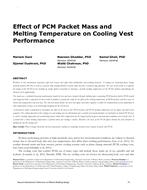Workers in hot environment experience high heat stresses that affect their productivity and working intervals. A cooling vest containing phase change material packets (PCMs) is used as a passive body cooling method to remove body heat for a relatively long duration. The aim of this work is to improve the design of the PCM-vest by making its weight lighter if possible or choosing a suitable melting temperature of the PCMs without jeopardizing the duration of its applicability.The study uses a validated transient mathematical model of heat and mass transfer through clothing layers containing PCM packets (fabric-PCM model) and integrated with a segmental bio-heat model to perform a parametric study on the effect of the melting temperature of PCM packets and their mass on trunk skin temperature and heat loss. The bio-heat model divides the torso into upper and lower segments to allow the incorporation of non-uniformity in skin temperature of torso as an interacting boundary for the PCM-vest.A parametric study is performed to investigate the effect of the mass of the PCM packets and PCM melting temperature on the upper and lower torso segments. The cooling duration of the cooling vest and cooling rate are determined and a number of recommendations are developed on desired PCM mass as well as melting temperature for maintaining lowest trunk skin temperature for the longest period in given environmental conditions and activity level. It is found that a lower melting temperature is favored when fast cooling is needed. Moreover, the mass of the PCM affects directly the total duration of melting but not the cooling rate.Key-words: Phase Change Material; bio-heat and passive cooling vest modeling; transient heat transfer in fabric and PCM.
Citation: 2nd Intl Conf: Efficient Bldg Design
Product Details
- Published:
- 2016
- Number of Pages:
- 7
- Units of Measure:
- Dual
- File Size:
- 1 file , 480 KB
- Product Code(s):
- D-ICEB16-10
